Last Updated on: February 5, 2025
Who would love creatures that look and sound spooky? Not to mention they are mythical avians that signify a bad omen.
However…
For birders like you, there’s more to owls in Massachusetts beyond the myths and superstitions.
Hence, we will tell you which owls inhabit this birding haven that the Mass Audubon says has over 300 avians. We’ll also tell you where owls live in this state and whether they’re lovable backyard visitors.
8 Owls In Massachusetts: Color Pattern, Behavior & Nesting Habits
Yes, this state has eight species. It’s not a small number, given that the United States has 19 species only. Here’s a list of the ones in MA.
1. Great Horned Owl
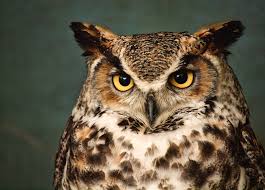
It should be the first to see because it’s the most common species throughout North America. Its adaptive nature lets it find a habitat anywhere, even in the tropics, deserts, and grasslands.
A great horned owl is a large raptor, so you can’t miss it. It’s between 18.1 and 24.8 inches long, with a wingspan of up to 57 inches, such a magnificent sight when you see it soaring. Its long tufts, gray-brown body, and white throat are unmistakable.
Both sexes hoot; however, the male does so at a lower pitch, although you’ll still hear it from several miles away.
It eats large prey, and its diet includes rabbits, birds, geese, and raptors like peregrine falcons. Nevertheless, when there’s a small animal that looks appetizing, a great-horned owl will gladly enjoy it. So, we can add mice, insects, and scorpions to its food choices.
Fortunately, great-horned owls nest in the same place severally, so once you spot an empty nest, go back in the next breeding season to meet the owners.
2. Barred Owl

A barred owl is a few inches smaller than a great horned owl because it’s between 16.9 and 19.7 inches long.
Barred owls have a unique call that differentiates them from other owls. You’ll think it wants to know, “Who cooks for you?” That’s why some call it the hoot owl.
This nocturnal bird lurks in the dark, watching you as you catch up with other birders around a campfire, and flies away if you approach or a great-horned owl pops in. A barred owl eats birds, snakes, turtles, moles, and squirrels. You may also see it catching insects around your campsite.
It gets its name from its mottled pattern of horizontal and vertical stripes. Its round head and black eyes stand out. However, a barred owl doesn’t have ear tufts like the great horned owls.
Barred owls have one of the largest populations throughout the United States.
3. Eastern Screech Owl

An eastern screech owl is stocky, about the size of an American robin, and doesn’t have a neck. It’s a tiny owl compared with the two species we’ve looked at above, as its average body length is between 6.3 and 9.8 inches.
Unlike the two birds above, an eastern screech owl has either rufous or grayish bodies with a unique spotted pattern for camouflage. You may not notice an eastern screech owl perched on a tree trunk unless you spot the ear tufts first since they stand out.
Given its small size, you would expect an eastern screech owl to eat only tiny animals like insects and earthworms, but it has an appetite for small mammals, tadpoles, and crayfish.
Eastern screech owls are decreasing because they love deciduous forests now threatened by deforestation. Luckily, Massachusetts is in the bird’s resident range as this species only inhabits eastern states.
4. Northern Saw-whet Owl
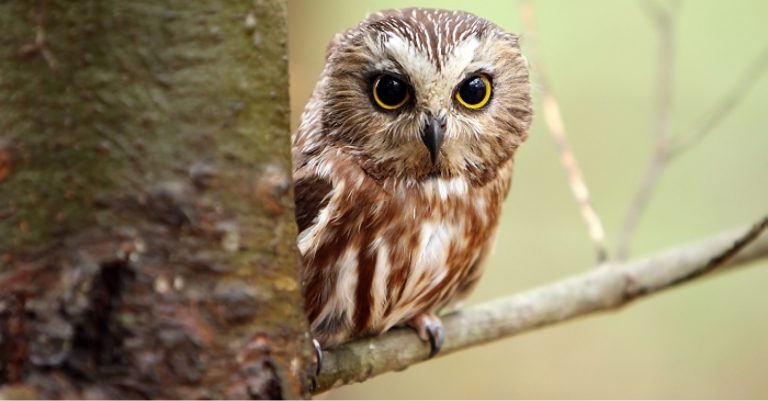
It’s almost the size of eastern screech owls as its average bill-to-tail length is between 7.1 and 8.3 inches. However, that’s as far as their similarities go because they have different plumage.
A northern saw-whet owl is the smallest of the owls in the eastern states. It has a white facial disk, a conspicuous white V between its yellow eyes, a mottled brown body, and white spots on its head. Have you seen such a bird?
It lacks ear tufts, so that’s one of the ways you can tell it apart from others you see in Massachusetts.
These owls are widespread and seen in Massachusetts throughout the year. Northern Massachusetts sits in the resident range, while the southern area is within the wintering range that extends to southern states.
If your search is fruitless, check tree holes left by pileated woodpeckers because northern saw-whet owls use them as nests. You might find four to seven eggs laid by this owl species. A northern saw-whet owl can also use a nest box; consequently, you can install one if there are no chickadees, titmice, or wrens in your backyard, or this raptor will eat them.
5. Short-eared Owl
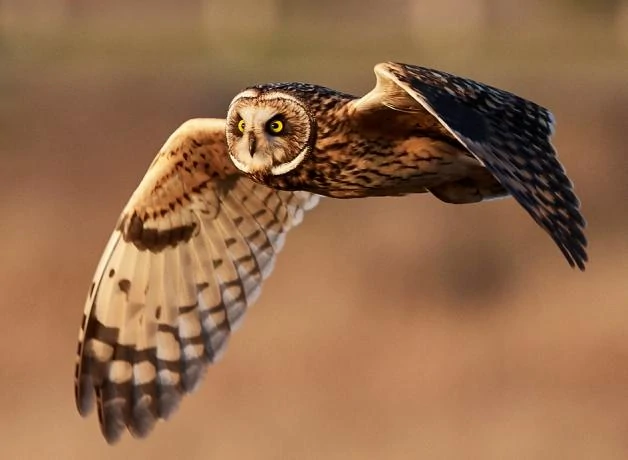
It’s a winter visitor in Massachusetts that arrives after its breeding period in the northern states.
A short-eared owl is almost twice the size of a northern saw-whet owl since its bill-to-tail length averages 13.4 to 16.9 inches. It has ear tufts, although small ones that you might miss. Additionally, a short-eared owl has a pale face, yellow eyes set inside black circles, and a mottled body. You also see the rounded tips of its broad wings as it flies.
A short-eared owl isn’t nocturnal, so it won’t have you waiting in the dark like most owls. Plus, it flies low to catch small mammals. The only disadvantage is that short-eared owls don’t hoot as loudly as other owls; therefore, you probably won’t hear them.
6. Long-eared Owl
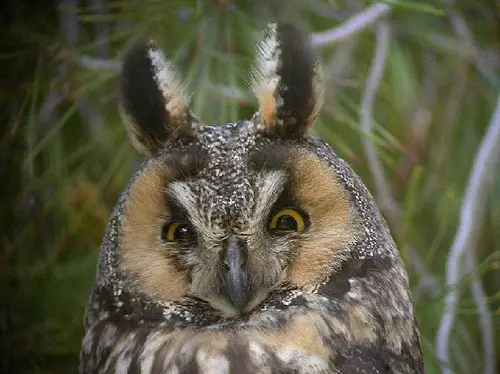
As the name suggests, you will come across avians with long ear tufts that differentiate them from the short-eared owl species.
There’s a resident population of long-eared owls in most of Massachusetts; however, the eastern region is in the wintering range. You can tell a long-eared owl by its black and brown feather pattern, large ear turfs, yellow eyes, and buff face.
You’d expect an owl with such tufts to have a large body, but a long-eared owl is between 13.8 and 15.8 inches long. It’s not even the size of a barred owl or northern hawk owls.
A long-eared owl roosts in dense forests because it’s nocturnal and hunts rabbits, mice, and rats in grasslands. You will see a long-eared owl flying low or as it angles its ear tufts to listen to the movement of prey below its perch.
Although long-eared owls inhabit diverse forests, their population is declining because of deforestation.
Unlike other owls that build their nests, long-eared owls reap where they haven’t sowed by taking over other birds’ homes, such as nests built by American crows, black-billed magpies, and common ravens. They lay up to 10 eggs per clutch.
7. Snowy Owl
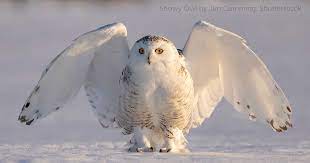
Massachusetts is home to wintering snowy owls that fly beyond their wintering range in the northern states and southern Canada.
Adult snowy owls have minimal black or brown marks; therefore, it’s difficult to see their white bodies in the snow unless you hear their hoarse croak and turn your binoculars in that direction.
Another option is looking for hollows in the ground a snowy owl uses as nests. If such a nest belongs to a snowy owl, you find three to eleven white eggs inside.
Snowy owls are between 20.5 and 27.9 inches long. These diurnal birds eat lemmings, birds, rodents, and squirrels. Sadly, North America’s snowy owl population is declining due to habitat loss in the western forests.
8. Barn Owl
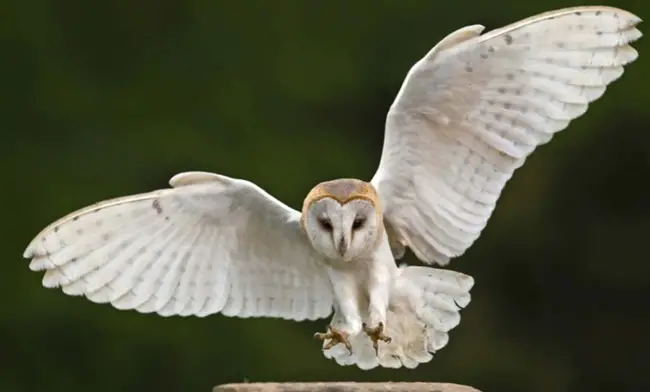
The most striking feature is its face, which earns the barn owl several names, such as the monkey-faced or ghost owl. Its heart-shaped white face staring back at you through the branches is the first thing you see when looking for this nocturnal bird.
A barn owl is a few inches smaller than a great horned owl, boasting an average body length of 12.6 to 15.8 inches, almost the size of a northern hawk owl.
In addition to white faces, these owls have white underbellies and underwings. Their backs are buff, and you will also notice they have long round wings just like their faces. When you look at a female barn up close, you see some spots on its chest.
The American Bird Conservancy, which we shall link later in the article, estimates the United States and Canada have about 120,000 barn owls. It can only mean one thing: the barn owl species is declining. One reason for this is habitat loss because barn owls inhabit agricultural fields, deserts, and grasslands.
Lastly, barn owls eat small rodents and nest in tree cavities or barns. You might also find their nests in an abandoned building.
Watch This!
Frequently Asked Questions
Is it OK to have owls in your yard?
Yes and no, and we’ll explain why. Owls are excellent visitors if you have a persistent pest problem in your backyard because, as you learned above, they have an appetite for rats, voles, mice, and even squirrels.
By inviting more owls, you’ll exterminate pests destroying your fruit garden cheaply, unlike when you have to set up pest control decoys. On top of that, since owls eat pests, you don’t have to cater to owls in your bird feeding budget. No seeds or fruit slices!
The issue comes when your backyard has small birds that raptors eat, such as robins, waxwings, chickadees, and titmice because then you have to choose between owls and other avians.
Are there great horned owls in Massachusetts?
Yes, they are among the eight species in this state.
What is the most common owl species in Massachusetts?
The great-horned owl species is a common sighting, although the population of northern saw-whet owls is also high.
Conclusion
How many of the eight owl species have you spotted so far? If you didn’t spot them in Massachusetts, prepare for an unforgettable experience in this state, from looking for a snowy owl in the tundra to watching short-eared owls tearing up small mammals in the grasslands.
Based on what we’ve told you in this article, don’t you agree that owls are interesting avians, even those with funny faces like the barn owl?

